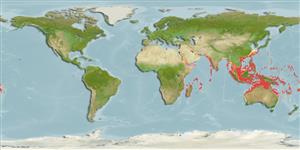Common names from other countries
>
Mulliformes (Goatfishes) >
Mullidae (Goatfishes)
Etymology: Parupeneus: Latin, parum, parvum = small + Peneus, the name of a river.
More on author: Lacepède.
Environment: milieu / climate zone / depth range / distribution range
Ecologia
marinhas associadas(os) a recifes; não migratória; intervalo de profundidade 0 - 125 m (Ref. 90102). Tropical; 30°N - 35°S, 35°E - 124°W (Ref. 54393)
Indo-Pacific: Red Sea and east coast of Africa south to Durban, South Africa, east to the Hawaiian Islands, islands of French Polynesia and the Pitcairn Islands, north to the Ryukyu Islands and Ogasawara Islands, Japan south to Australia.
Tamanho / Peso / Idade
Maturity: Lm ? range ? - ? cm
Max length : 50.0 cm TL macho/indeterminado; (Ref. 30573); common length : 35.0 cm TL macho/indeterminado; (Ref. 30573); peso máx. publicado: 2.3 kg (Ref. 4887)
Espinhos dorsais (total) : 8; Raios dorsais (total) : 9; Espinhos anais: 1; Raios anais : 7. This species is distinguished by the following characters: pectoral rays 16 (rarely 15 or 17); gill rakers 6-7 + 22-26 = 29-33; body depth 3.25-3.8 in SL (body deeper with growth); head length (HL) 2.85-3.1 in SL; snout long, its length 1.61.8 in HL; eye small, the orbit diameter 5.3-8.95 in HL (SL 118-392 mm); barbels very long, 1.15 in HL to longer than head; longest dorsal spine 1.5-1.7 in HL; penultimate dorsal ray 1.1-1.2 in length of last dorsal ray; pectoral-fin length 1.5-1.7 in HL; pelvic-fin length 1.35-1.55 in HL. Colour of large adults yellowish gray, edges of the scales bright blue except ventrally, edges more broadly blue posteriorly; a large, hemispherical, saddle-like, yellow spot covering most of upper half of caudal peduncle; region around eye yellow with radiating short narrow blue bands; caudal fin with longitudinal blue bands; second dorsal and anal fins with narrow oblique blue bands; a second smaller color phase entirely yellow, with dorsal peduncular spot sometimes apparent by being brighter yellow than rest of body (Ref. 54393).
Found on coral (Ref. 58652), rocky, or rubble bottoms of reef flats, lagoons, and seaward reefs (Ref. 3921). Benthopelagic (Ref. 58302). Juveniles form schools, adults usually solitary. Feed primarily on small fishes, crustaceans, peanut worms, shrimps, crabs, octopi, and small gastropods during the day (Ref. 3921). Minimum depth reported taken from Ref. 128797.
Ciclo de vida ou comportamento de acasalamento
Maturities | Reprodução | Spawnings | Egg(s) | Fecundities | Larvas
Randall, J.E., 2004. Revision of the goatfish genus Parupeneus (Perciformes: Mullidae), with descriptions of two new species. Indo-Pac. Fish. (36):64 p. (Ref. 54393)
Status na Lista Vermelha da UICN (Ref. 130435)
CITES (Ref. 128078)
Not Evaluated
Ameaça para os humanos
Reports of ciguatera poisoning (Ref. 4690)
Uso pelos humanos
Pescarias: espécies comerciais; peixe esportivo: sim; Aquário: Espécies comerciais
Ferramentas
Relatórios especiais
Baixar XML
Fontes da internet
Estimates based on models
Preferred temperature (Ref.
115969): 24.5 - 29, mean 27.8 (based on 1578 cells).
Índice de diversidade filogenética (Ref.
82804): PD
50 = 0.5000 [Uniqueness, from 0.5 = low to 2.0 = high].
Bayesian length-weight: a=0.01230 (0.00783 - 0.01932), b=3.09 (2.96 - 3.22), in cm Total Length, based on LWR estimates for this species & Genus-body shape (Ref.
93245).
Nível Trófico (Ref.
69278): 4.2 ±0.6 se; based on diet studies.
Resiliência (Ref.
120179): médio(a), tempo mínimo de duplicação da população 1,4 - 4,4 anos (Preliminary K or Fecundity.).
Fishing Vulnerability (Ref.
59153): Moderate vulnerability (40 of 100).
